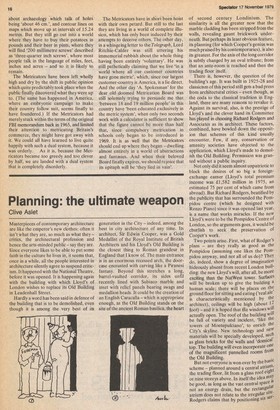Planning: the ultimate weapon
Clive Aslet
Masterpieces of contemporary architecture are like the emperor's new clothes: often it isn't what they are, so much as what they — critics, the architectural profession and hence the arts-minded public — say they are. Since everyone likes to be able to put some faith in the culture he lives in, it seems that, once in a while, all the people interested in architecture silently agree to suspend criticism. It happened with the National Theatre, before it was opened. It is happening again with the building with which Lloyd's of London wishes to replace its Old Building in Leadenhall Street.
Hardly a word has been said in defence of the building that is to be demolished, even though it is among the very best of its generation in the City — indeed, among the best in city architecture of any tithe. Its architect, Sir Edwin Cooper, was a Gold Medallist of the Royal Institute of British Architects and his Lloyd's Old Building is the closest thing to Roman grandeur in England that I know of. The main entrance is in an enormous recessed arch, the doorcase encrusted with carving like a Piranesi fantasy. Beyond this stretches a long, barrel-vaulted corridor, its sides until recently lined with Subiaco marble and inset with relief panels bearing swags and medallion heads. It could be the creation of an English Caracalla — which is appropriate enough, as the Old Building stands on the site of the ancient Roman basilica, the heart of second century Londinium. The similarity is all the greater now that the marble cladding has been stripped from the walls, revealing gaunt brickwork underneath. But perhaps its least obvious feature, its planning (for which Cooper's genius was much praised by his contemporaries), is also its greatest. For the axis of the long corridor is subtly changed by an oval tribune; from that an ante-room is reached and then the trading floor itself.
There is, however, the question of the building's age. It was built in 1925-28 and classicism of this period still gets a bad press from architectural critics — even though, as the coda to the classical tradition in England, there are many reasons to revalue it. Against its survival, also, is the prestige of Lloyd's and the clever hand its Committee has played in choosing Richard Rodgers and Associates as its architect. These factors, combined, have bowled down the opposition that schemes of this kind usually encounter. Few, if any, conservation or amenity societies have objected to the application, which Lloyd's made to demolish the Old Building. Permission was granted without a public inquiry.
Not only did it seem almost unpatriotic to block the desires of so big a foreignexchange earner (Lloyd's total premium income was £1,582 million in 1975, an estimated 75 per cent of which came from abroad). But Richard Rodgers, beatified by the publicity that has surrounded the P0111 . pidou centre (which he designed with Renzo Piano) since it was opened last year,, is a name that works miracles. If the new Lloyd's were to be the Pompidou Centre of London, so the arguments goes, it would be churlish to seek the preservation of Cooper's work.
Two points arise. First, what of Rodger's plans — are they really as good as the Pompidou (assuming one likes the Pompidou anyway, and not all of us do)? They do, indeed, show a degree of imagination hideously absent from recent London building: the new Lloyd's will, after all, be more excifing than the NatWest tower. Surfaces will be broken up to give the building a human scale; there will be places on the, ground floor for sitting and eating ('real ale is characteristically mentioned by the architect), ceilings will be high (about 1.2 foot) — and it is hoped that the windows vv111 actually open. The roof of the building will be full of variety and incident, 'like the towers of Montepulciano', to enrich the City's skyline. New technology and new materials will be specially developed, such, as glass bricks for the walls and 'donne& top. The building will even incorporate one of the magnificent pannelled rooms froin the Old Building. But not everyone is won over by the basic scheme — planned around a central atrium: the trading floor, lit from a glass roof eight or nine storeys above. In itself the idea maY be good, as long as the vast central space 15, not an energy drain, but the rectangu.11" atrium does not relate to the irregular siter: Rodgers claims that by positioning six se vice towers at the boundaries of the site, he will maintain the street line — in the manner of G.E. Street's Law Courts in the Strand. But the comparison is superficial, for the solid-looking parts of Rodger's towers will be kitchenettes, pantries and toilets — not things which Street would have chosen to stake out the perimeter of his design. Row upon row of loos will be the first sight of the new Lloyd's for a pedestrian in Leadenhall Street.
The second and most important point, however, is the grounds on which demolition of the Old Building was granted. Surely it is wrong to permit the destruction of one building of proven quality for another which, it is assumed, may be better? Not only are such matters notoriously difficult to judge from plans and elevations alone, but many things may happen between planning and building. If economies are called for by the client, the scheme will be modified and the materials made cheaper — and the final result will turn out very different from what was originally conceived.
If one allows the 'better-than-whatyou've-got' argument to gain ground, none of our 'protected' buildings will be safe: and, in fact, word has already gone round about this new way of disarming conservationist opposition. Greycoat Estates — sleeves still rolled after the demolition of the magnificient complex of 18th-century warehouses on Cutler Street — have taken heed and called in Rodgers to wave his wand over their intractable Coin Street 'development on the South Bank. One waits to see who will be the next developer to summon up what might become the ultimate planning weapon.
Lloyd's may have pulled off a coup. It may build itself one of the last if the energy crisis worsens — great 'prestige' headquarters in London. But perhaps there is a hidden pitfall. There are indications that most Lloyd's members are apathetic to the development — in the vote taken last year, no more than 906 voted out of 14,091 (the total has risen to about 17,000 now). But they may not continue to be so unconcerned. For members of Loyd's presently enjoy tax advantages for the unlimited liability to which they may be committed. Redeveloping the Old Building will be a new source of profit, but of a different kind. Only half the replacement will be used by Lloyd's, at least to begin with: the rest (80,000 square feet or so) will be let commercially. And the present New Building will fall vacant, to be let as it is, or even redeveloped. Thus Lloyd's will not only have a new and enlarged 'Room', as the trading floor is called; it will also have a prime property speculation. But this is one for which no risks will have been taken, and which will provide another argument for the removal of that preferential tax treatment which many observers already consider unjustifiable. The new Lloyd's may, eventually, cost its members dear.







































 Previous page
Previous page